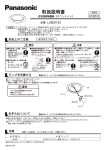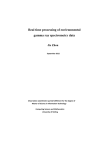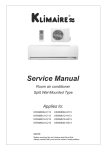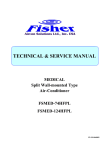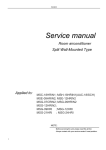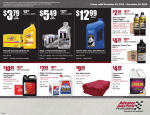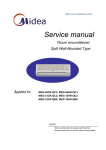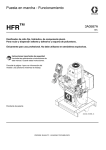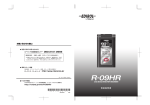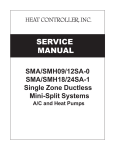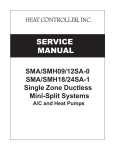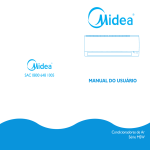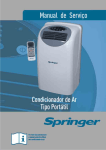Download Service Manual - BrandsMart USA
Transcript
Cover Service Manual PIA9064A/65B PIA9066A/67B PIA12064A/65B PIA12066A/67B PIA18064A/18065B PIA18066A/18067B Content Content 1. Precaution 2 1.1 Safety Precaution 2 1.2 Warning 2 2. Function 4 3. Dimension 6 3.1 Indoor unit 6 3.2 Outdoor unit 6 4. Refrigerant cycle diagram 11 5. Operation limits 12 5.1 Cooling operation 12 5.2 Heating operation 12 6. Wiring diagram 14 7. Installation details 21 7.1 Wrench torque sheet for installation 7.2 Connecting the cables 21 21 7.3 Pipe length and the elevation 21 7.4 Air purging of the piping and indoor unit 7.5 Pumping down (Re-installation) 23 24 7.6 Re-air purging (Re-installation) 25 7.7 Balance refrigerant of the 2-way, 3-way valves 26 7.8 Evacuation 27 7.9 Gas charging 8. 28 Electronic function 29 8.1 Proper symbols and their meaning 29 8.2 Function 29 8.3 Protection 29 8.4 Fan-only mode 30 8.5 Cooling mode 30 8.6 Dehumidifying mode 31 8.7 Heating mode 32 8.8 Defrosting mode (available for heating mode) 8.9 Auto mode 34 8.10 Force cooling function 35 8.11 Sleep mode 35 8.12 Auto restart function 35 8.13 Turbo mode 35 9. 2 Model and Parameters 36 33 Content 10. Troubleshooting 37 10.1 Display board 37 10.2 Troubleshooting 37 10.3 Diagnostic chart 38 10.4 Resetting phenomenon often occurs during operation. 10.5 Operation lamp flashes and Timer lamp off. 39 10.6 Operation lamp flashes and Timer lamp on. 39 10.7 Operation lamp off and Timer lamp flashes 40 10.8 Operation lamp on and Timer lamp flashes 40 10.9 Operation lamp flashes, Timer lamp flashes . 11. Characteristic of temperature sensor 3 41 40 39 Service manual 1. Precaution 1.1 Safety Precaution To prevent injury to the user or other people and property damage, the following instructions must be followed. Incorrect operation due to ignoring instruction will cause harm or damage. Before service unit, be sure to read this service manual at first. 1.2 Warning Installation Do not use a defective or underrated circuit breaker. Use this appliance on a dedicated circuit. Do not let the air conditioner run for a long There is risk of fire or electric shock. For electrical work, contact the dealer, seller, a qualified electrician, or an Authorized service center. Do not disassemble or repair the product, there is risk of fire or electric shock. Always ground the product. There is risk of fire or electric shock. Install the panel and the cover of control box securely. There is risk of fire of electric shock. Improper wiring or installation may cause fore or electric shock. Use the correctly rated breaker of fuse. There is risk of fire or electric shock. Do not modify or extend the power cable. There is risk of fire or electric shock. Do not install, remove, or reinstall the unit by There is risk of fire, electric shock, explosion, or injury. Be caution when unpacking and installing the Moisture may condense and wet or damage furniture. Take care to ensure that power cable could not be pulled out or damaged during operation. There is risk of fire or electric shock. Do not place anything on the power cable. There is risk of fire or electric shock. during operation. There is risk of fire or electric shock. Do not touch (operation) the product with wet hands. There is risk of fire or electric shock. Do not place a heater or other appliance near the power cable. There is risk of fire and electric shock. It may cause fire, failure of the product, or electric shock. Do not store or use flammable gas or combustible near the product. product. Sharp edges could cause injury, be especially careful of the case edges and the fins on the condenser and evaporator. For installation, always contact the dealer or There is risk of fire or failure of product. Do not use the product in a tightly closed space for a long time. Oxygen deficiency could occur. When flammable gas leaks, turn off the gas an Authorized service center. There is risk of fire, electric shock, explosion, or injury. Do not install the product on a defective installation stand. It may cause injury, accident, or damage to the product. 2 or a windows is left open. Do not allow water to run into electric parts. yourself (customer). deteriorate with age. time when the humidity is very high and a door Do not plug or unplug the power supply plug Always install a dedicated circuit and breaker. Be sure the installation If the base collapses, the air conditioner could fall with it, causing property damage, product failure, and personal injury. area does not and open a window for ventilation before turn the product on. Do not use the telephone or turn switches on or off. There is risk of explosion or fire. If strange sounds, or small or smoke comes from product. Turn the breaker disconnect the power supply cable. There is risk of electric shock or fire. off or Service manual Stop operation and close the window in storm or hurricane. If possible, remove the product from the window before the hurricane arrives. There is risk of property damage, failure of product, or electric shock. Do not open the inlet grill of the product during operation. (Do not touch the electrostatic filter, if the unit is so equipped.) There is risk of physical injury, electric shock, or product failure. When the product is soaked (flooded or submerged), contact an Authorized service center. There is risk of fire or electric shock. Be caution that water could not enter the product. There is risk of fire, electric shock, or product damage. Ventilate the product from time to time when operating it together with a stove, etc. There is risk of fire or electric shock. Turn the main power off when cleaning or maintaining the product. There is risk of electric shock. When the product is not be used for a long time, disconnect the power supply plug or turn off the breaker. There is risk of product damage or failure, or unintended operation. Take care to ensure that nobody could step on or fall onto the outdoor unit. This could result in personal injury and product damage. CAUTION Always check for gas (refrigerant) leakage after installation or repair of product. Low refrigerant levels may cause failure of product. Install the drain hose to ensure that water is drained away properly. A bad connection may cause water leakage. Keep level even when installing the product. To avoid vibration of water leakage. Do not install the product where the noise or hot air from the outdoor unit could damage the neighborhoods. It may cause a problem for your neighbors. Use two or more people to lift and transport the product. 2 Avoid personal injury. Do not install the product where it will be exposed to sea wind (salt spray) directly. It may cause corrosion on the product. Corrosion, particularly on the condenser and evaporator fins, could cause product malfunction or inefficient operation. Service manual Operational Do not expose the skin directly to cool air for long periods of time. (Do not sit in the draft). This could harm to your health. Do not use the product for special purposes, such as preserving foods, works of art, etc. It is a consumer air conditioner, not a precision refrigerant system. There is risk of damage or loss of property. Do not block the inlet or outlet of air flow. It may cause product failure. Use a soft cloth to clean. Do not use harsh detergents, solvents, etc. There is risk of fire, electric shock, or damage to the plastic parts of the product. Do not touch the metal parts of the product when removing the air filter. They are very sharp. There is risk of personal injury. Do not step on pr put anything on the product. (outdoor units) conditioner and could cause product malfunction or damage. Do not insert hands or other object through air inlet or outlet while the product is operated. There are sharp and moving parts that could cause personal injury. Do not drink the water drained from the product. It is not sanitary could cause serious health issues. Use a firm stool or ladder when cleaning or maintaining the product. Be careful and avoid personal injury. Replace the all batteries in the remote control with new ones of the same type. Do not mix old and mew batteries or different types of batteries. There is risk of fire or explosion. Do not recharge or disassemble the batteries. Do not dispose of batteries in a fire. They may burn of explode. If the liquid from the batteries gets onto your skin or clothes, wash it well with clean water. There is risk of personal injury and failure of product. Do not use the remote of the batteries have Always insert the filter securely. Clean the The chemical in batteries could cause burns or other health hazards. filter every two weeks or more often if necessary. A dirty filter reduces the efficiency of the air 3 leaked. Service manual 2. Function Indoor unit Operation ON/OFF by remote controller Sensing by room temperature Room temperature sensor. Pipe temperature sensor. Room temperature control Maintain the room temperature in accordance with the setting temperature. Starting temperature control Indoor fan is delayed for 5 sec at the starting Time Delay Safety control Restarting is for approx. 3 minutes.. Indoor fan speed control high, med, low, breeze. Operation indication Lamps (VLED) Light up in the VLED for each operation mode. Two-direction air vane The unit will decide the louver direction according to operation mode. Sleep mode auto control The fan is turn to low speed (cooling/heating). The unit will be turn off at the seventh hour. Independent dehumidification The function is usually used in rainy days in springtime or damp areas. Self-diag. function Turbo mode Anti-cold function Prevent the cold wind at the beginning of unit Defrost mode The function will be operate in any operation Air flow Direction control The louver can be set at the desired position or swing up and down automatically Auto-restart function Flexible wiring connection Auto mode The unit can be change by the room temperature. 4 Easy clean panel Service manual Outdoor unit Power relay control The unit has 3 mins delay between continuously ON/OFF operations. Low noise air flow system Bird tail propeller fan makes the outdoor unit run more quietly. Hydrophilic aluminum fin The hydrophilic fin can improve the heating efficiency at operation mode. 4 way valve control It is only operated in the heating operation mode except defrosting operation. Discharge pipe temperature protect Anti-rust cabinet Valve protection cover 5 Service manual 3. Dimension 3.1 Indoor unit 1.3 Dimension W H D 7/9/12K 790 275 195 18K 928 275 195 Mode 3.2 Outdoor unit Dimension W H D L1 L2 L3 7K(B4) 685 430 276 460 300 445 9K(B4) 685 430 276 460 300 445 9K(B6) 700 522 250 458 275 537 12K(B4) 700 522 250 458 275 537 12K(B6) 780 540 266 549 290 555 18K(B4) 780 540 266 549 290 555 Mode 6 Service manual Specification: Model Power supply Capacity Cooling Input MSR-07CR MSR-07HR MSR-09CR MSR-09HR Btu/h 1Ph, 220-230V~, 60Hz 7000 1Ph, 220-230V~, 60Hz 7000 1Ph, 220-230V~, 60Hz 9000 1Ph, 220-230V~, 60Hz 9000 W 800 800 1000 1000 4.6 Ph-V-Hz A 3.7 3.7 4.6 Btu/w.h 8.75 8.75 8.5 8.5 Btu/h —— 7000 —— 9000 Input W —— 680 —— 850 Rated current A —— 3.1 —— 3.9 Btu/w.h —— W 950 10.3 950 —— 1200 10.6 1200 Max. current A Starting current A 4.2 17 4.2 17 5.8 22 5.8 22 Model 39R172BS-530 39R172BS-530 44R232AE-FJS 44R232AE-FJS Type Rotary Rotary Rotary Rotary Brand RECHI RECHI RECHI RECHI Rated current EER Capacity Heating COP Max. input consumption Capacity Compressor Btu/h 6107 6107 7677 7677 Input W 700 700 840 840 Rated current(RLA A 3.1 3.1 3.8 3.8 Locked rotor Amp( A 17 17 22 22 MAR12090-9054 MAR12090-9054 Tongba0B175-145B-141C TongbaoB175-145B-141C 20μF/370V 210 20μF/370V 210 25μF/370V 270 25μF/370V 270 Model RPG13M RPG13M RPG13M RPG13M Brand Welling Welling Welling Welling 35W/1520RPM 35W/1520RPM 35W/1520RPM 1.5μF/450V 1.5μF/450V 1150/1000/850 430/373/318 1150/1000/850 430/373/318 Thermal protector Capacitor μF Refrigerant oil ml Indoor fan moInput μF 1.5μF/450V 35W/1520RPM 1.5UF/450V r/min 1050/900/800 1050/900/800 Indoor air flow (Hi/Mi/Lo) m3/h Indoor noise level (Hi/Mi/Lo) dB(A) 370/317/282 39/36/32 370/317/282 39/36/32 Dimension (W×H× mm 790×275×190 790×275×190 40/37/33 790×275×190 40/37/33 790×275×190 Packing (W×H×D mm 865×350×265 865×350×265 865×350×265 865×350×265 Net/Gross weight Kg 8.5/10.5 8.5/10.5 8.5/10.5 8.5/10.5 YDK23-4B YDK23-4B YDK23-4B YDK23-4B DY 62 DY 62 DY 62 DY 62 2.0μF/450V 950 2.0μF/450V 950 2.0μF/450V 950 2.0μF/450V 950 Capacitor Speed(hi/mi/lo) Indoor unit W Model Brand Outdoor fan mInput Capacitor Speed W μF r/min Outdoor air flow m3/h Outdoor noise level dB(A) 1250 52 1250 52 1250 54 1250 54 Dimension(W×H×D mm 685×430×260 685×430×260 685×430×260 685×430×260 Outdoor unit Packing (W×H×D) mm 795×495×345 795×495×346 795×495×347 795×495×348 Kg 21/24 22/25 24/27 25/28 Refrigerant type g R22/500 R22/530 R22/560 R22/560 Design pressure MPa Net/Gross weight Liquid side/ Gas sidmm(inch) 2.6 2.6 2.6 2.6 Ф6.35/Ф9.53 Ф6.35/Ф9.53 Ф6.35/Ф9.53 Ф6.35/Ф9.53 10 Refrigerant p Max. refrigerant pip m 10 10 10 Max. difference in l m 5 5 5 5 Operation temp ℃ 17-30 17~30 17~30 17~30 Ambient temp ℃ m2 18-45 -7~45 18~ 45 -7~45 10~14 10~14 14~20 14~20 Application area Note: The noise date is base on hemi-anechoic chamber during actual operation, these values are normally somewhat different as a result 7 Service manual of ambient condition. The above design and specifications are subject to change without prior notice for product improvement. Model Power supply MSR-12CR MSR-12HR 1Ph, 220-230V~, 60Hz 1Ph, 220-230V~, 60Hz 12000 Btu/h 9000 9000 Input W 1050 1050 1350 1350 Rated current A 4.6 4.6 6.2 6.2 Btu/w.h 8.6 8.6 8.2 8.2 Btu/h —— 10000 —— 12000 Input W —— 1020 —— 1300 Rated current A —— 4.45 —— 6 —— 1650 2.6 1650 8.8 30 8.8 30 44R312AG-FJSC EER Capacity Heating MSR-09HR 1Ph, 220-230V~, 60Hz 1Ph, 220-230V~, 60Hz 12000 Capacity Cooling MSR-09CR Ph-V-Hz COP Btu/w.h —— 2.88 W 1300 1300 Max. current A 6.3 6.3 Starting current A 26 26 2P15S236A1E Rotary 2P15S236AIE Rotary 44R312AG-FJSC Type Rotary Rotary Brand GD MATSUSHITA GD MATSUSHITA RECHI RECHI Btu/h 10130 10130 10782 10782 Input W 930 930 1185 1185 Rated current(RLA A 4.1 4.1 5.3 5.3 Locked rotor Amp( A 26 26 30 30 MRA99027 MRA99027 TongbaoB245-140B-141H TongbaoB245-140B-141H Max. input consumption Model Capacity Compressor Thermal protector Capacitor μF 30μF/330V 30μF/330V Refrigerant oil ml 270 270 30μF/370V 270 30μF/370V 270 Model RPG13M RPG13M RPG13M RPG13M Brand Welling Welling Welling Welling 35W/1520RPM 35W/1520RPM 35W/1520RPM 35W/1520RPM Indoor fan moInput W μF 1.5μF/450V 1.5μF/450V 1.5μF/450V 1.5μF/450V r/min 1250/1100/850 1250/1100/850 Indoor air flow (Hi/Mi/Lo) m3/h dB(A) 450/400/350 39/36/32 1220/1100/850 480/432/335 Indoor noise level (Hi/Mi/Lo) 450/400/350 39/36/32 1220/1100/850 480/432/335 43/41/33 43/41/33 Dimension (W×H× mm 790×275×190 790×275×190 790×275×190 790×275×190 Packing (W×H×D mm 865×350×265 865×350×265 865×350×265 865×350×265 Net/Gross weight Kg 8.5/10.5 8.5/10.5 9/11 9/11 Model YDK30-6B YDK30-6B YDK30-6B YDK30-6B Brand Welling Welling Welling Welling Capacitor Speed(hi/mi/lo) Indoor unit Outdoor fan mInput Capacitor Speed W 72 72 72 72 μF 2.5μF/450V 2.5μF/450V 2.5μF/450V 2.5μF/450V r/min 860 860 860 860 Outdoor air flow m3/h 1800 Outdoor noise level 1500 57 1500 57 dB(A) 1800 53 Dimension(W×H×D mm 700×535×250 53 700×535×250 700×535×250 700×535×250 Outdoor unit Packing (W×H×D) mm 815×580×325 815×580×325 815×580×325 815×580×325 Kg 28/31 28/31 27/29 28/30 Refrigerant type g R22/580 R22/700 R22/650 R22/850 Design pressure MPa 2.6 2.6 2.6 2.6 Net/Gross weight Ф6.35/Ф9.53 Ф6.35/Ф9.53 Ф6.35/Ф12.7 Ф6.35/Ф12.7 Refrigerant p Max. refrigerant pip m 10 10 10 10 Max. difference in l m 5 5 5 5 Operation temp ℃ 17-30 17-30 17~30 17~30 Ambient temp ℃ m2 18-45 -7 - 45 18~ 45 -7~45 14~20 14~20 18~24 18~24 Liquid side/ Gas sidmm(inch) Application area Note: The noise date is base on hemi-anechoic chamber during actual operation, these values are normally somewhat different as a result of ambient condition. 8 Service manual The above design and specifications are subject to change without prior notice for product improvement. Model Power supply MSR-18CR MSR-18HR 1Ph, 220-230V~, 60Hz 1Ph, 220-230V~, 60Hz 18000 Btu/h 12000 12000 Input W 1330 1330 1700 1700 Rated current A 6.1 6.1 8.7 8.7 Btu/w.h 9 9 9.4 9.4 Btu/h —— 14000 —— 17500 Input W —— 1400 —— 17500 Rated current A —— 6.4 —— 8.2 —— 2200 3.0 2200 10 40 10 40 PH240×2C-3FTU1 EER Capacity Heating MSR-12HR 1Ph, 220-230V~, 60Hz 1Ph, 220-230V~, 60Hz 18000 Capacity Cooling MSR-12CR Ph-V-Hz Btu/w.h —— 2.93 Max. input consumption COP W 1700 1700 Max. current A 8 8.5 Starting current A 32 32 Model PH195×2C-3FTU1 Rotary PH195×2C-3FTU1 Rotary PH240×2C-3FTU1 Type Rotary Rotary Brand GD TOSHIBA GD TOSHIBA GD TOSHIBA GD TOSHIBA 13716 13716 17500 17500 1325 1655 1655 5.8 7.26 7.26 Capacity Compressor Input Btu/h W Rated current(RLA A Locked rotor Amp( A Thermal protector 1325 5.8 32 32 40 40 UP3QE0591-T36 UP3QE0591-T36 UP3QE0591-T39 UP3QE0591-T39 Capacitor μF 40μF/370V 40μF/370V Refrigerant oil ml 480 480 40μF/370V 480 40μF/370V 480 Model RPG13M RPG13M RPG28E RPG28E Brand Welling Welling Welling Welling 35W/1520RPM 35W/1520RPM 55W/1180RPM 1.5UF/450V 55W/1180RPM 1.5UF/450V 1220/1100/850 780/703/550 1220/1100/850 780/703/550 Indoor fan moInput W μF 1.5μF/450V 1.5μF/450V r/min 1180/1000/850 1180/1000/850 Indoor air flow (Hi/Mi/Lo) m3/h Indoor noise level (Hi/Mi/Lo) 580/500/420 40/35/30 Capacitor Speed(hi/mi/lo) dB(A) 580/500/420 40/35/30 44.8/42.6/36 44.8/42.6/36 Dimension (W×H× mm 790×275×190 790×275×190 928×198×275 928×198×275 Packing (W×H×D mm 865×350×265 865×350×265 Net/Gross weight Kg 9.0/11.0 9.0/11.0 1015×265×350 10/13.5 1015×265×350 10/13.5 Model YDK25-6B YDK25-6B YDK36-6B YDK36-6B Brand Welling 82.5 Welling 82.5 Welling 85 Welling 85 2.5μF/450V 960 2.5μF/450V 2.5μF/450V r/min 2.5μF/450V 960 930 930 Outdoor air flow m3/h 2000 2000 Outdoor noise level dB(A) 54 780×540×250 2000 58 2000 58 Indoor unit Outdoor fan mInput Capacitor Speed W μF Dimension(W×H×D mm 54 780×540×250 780×540×250 780×540×250 Outdoor unit Packing (W×H×D) mm 910×575×335 910×575×335 910×335×575 910×335×575 Kg 34/37 34/37 34/37 35/38 Refrigerant type g R22/1280 MPa R22/900 2.6 R22/1150 Design pressure R22/700 2.6 2.6 2.6 Net/Gross weight Ф6.35/Ф12.7 Ф6.35/Ф12.7 Ф6.35/Ф12.7 Ф6.35/Ф12.7 Refrigerant p Max. refrigerant pip m 10 10 15 15 Max. difference in l m 5 5 8 8 Operation temp ℃ 17-30 17-30 17~30 17~30 Ambient temp ℃ m2 18-45 -7 - 45 18~ 45 -7~45 18~26 18~26 26~35 26~35 Liquid side/ Gas sidmm(inch) Application area Note: The noise date is base on hemi-anechoic chamber during actual operation, these values are normally somewhat different as a result of ambient condition. The above design and specifications are subject to change without prior notice for product improvement. 9 Service manual 10 Service manual 4. Refrigerant cycle diagram Cooling only Heat pump mode 11 Service manual 5. Operation limits 5.1 Cooling operation Outdoor unit air temp.℃ DB Indoor air temp. ℃ DB Note: The chart is the result from the continuous operation under constant air temperature conditions. However, excludes the initial pull-down stage. 5.2 Heating operation Indoor air temp. ℃ DB Outdoor unit air temp.℃ DB Note: The chart is the result from the continuous operation under constant air temperature conditions. However, excludes the initial pull-down stage. 12 Service manual 13 Service manual 6. Wiring diagram Indoor: MSR-07CR-NB4 Outdoor: MSR-07CR-NB4,MSR-09CR-NB4 14 Service manual Intdoor: MSR-09CR-NB4,MSR-12CR-NB4,MSR-12CR-NB6 Indoor: MSR-09CR-NB6 15 Service manual Outdoor : MSR-09CR-NB6,MSR-12CR-NB4,MSR-12CR-NB6 Indoor: MSR-09HR-NB4,MSR-09HR-NB6,MSR-12HR-NB4,MSR-12HR-NB6 16 Service manual Indoor: MSR-07HR-NB4 Outdoor: MSR-07HR-NB4,MSR-09HR-NB4 17 Service manual Outdoor: MSR-09HR-NB6,MSR-12HR-NB6 Outdoor: MSR-12HR-NB4 18 Service manual Indoor:MSR-18CR-NB4 Outdoor: MSR-18CR-NB4 Indoor: MSR-18HR-NB4 19 Service manual Outdoor: MSR-18HR-NB4 20 Service manual 7. Installation details 7.1 Wrench torque sheet for installation Outside diameter Torque mm inch Kg.m φ6.35 1/4 1.8 φ9.52 3/8 4.2 φ12.7 1/2 5.5 7.2 Connecting the cables The power cord of connect should be selected according to the following specifications sheet. Grade Unit mm 2 7.3 7K 9K 12K 18K 1.0 1.0 1.5 2.5 Pipe length and the elevation Pipe size Capacity Btu/h GAS LIQUID Standard Max. length Elevation (m) B (m) Max. Pipe length A (m) Additional refrigerant (g/m) 7K~9K 3/8’’ (φ9.52) 1/4’’ (φ6.35) 5 5 10 30 12K 1/2’’ (φ12.7) 1/4’’ (φ6.35) 5 5 10 30 18K 1/2’’ (φ12.7) 1/4’’ (φ6.35) 5 8 15 30 In case that more Caution: 21 than Service manual Capacity is base on standard length and maximum allowance length is base of reliability. Oil trap should be install per 5-7 meters. 22 Service manual 7.4 Air purging of the piping and indoor unit Required tools: Hexagonal wrench; adjustable wrench; torque wrenches, wrench to hold the joints and gas leak detector. Note: The air in the indoor unit and in the piping must be purged. If air remains in the refrigeration piping, it will affect the compressor, reduce the cooling capacity, and could lead to a malfunction of unit. Be sure, using a torque wrench to tighten the service port cap (after using the service port), so that it prevents the gas leakage from the refrigeration cycle. Procedure Mounted the valve stem nuts to the 2-way and Recheck the piping connections. 3-way valves. Open the valve stem of the 2-way valve Check for gas leakage. counterclockwise approximately 90’, wait 10 At this time, especially check for gas leakage seconds, and then set it to closed position. from the 2-way and 3-way stem nuts, and from Be sure to use a hexagonal wrench to operate the service port. the valve stem Check for gas leakage. Caution: Check the flare connection for gas leakage If gas leakage is discovered in step (3) above, Purge the air from the system. take the following measures. Set the 2-way valve to the open position and If the leaks stop when the piping connections remove the cap from the 3-way valve’s service are tightened further, continue working from port. step (4). Using the hexagonal wrench to press the If the gas leaks do not stop when the valve core pin, discharge for three seconds connections and then wait for one minute. location of the leak, discharge all of the gas Use torque wrench to tighten the service port through the service port, and then recharge cap to a torque of 1.8 kg.m. (18n.m) with the specified amount of gas from a gas Set the 3-way valve to the opened position. cylinder. 23 are retightened, repair the Service manual 7.5 Pumping down (Re-installation) Procedure Confirm that both the 2-way and 3-way valves are set to the opened position. Remove the valve stem caps and confirm that the valve stems are in the opened position. Be sure to use a hexagonal wrench to operate the valve stems. Operate the unit for 10 to 15 minutes. Stop operation and wait for 3 minutes, then connect the charge set to the service port of the 3-way valve. Connect the charge hose with the push pin to the gas service port. Air purging of the charge hose. Open the low-pressure valve on the charge set slightly to purge air from the charge hose. Set the 2-way valve to the close position. Operate the air conditioner at the cooling cycle and stop it when the gauge indicates 0.1MPa. Immediately set the 3-way valve to the closed position. Do this quickly so that the gauge ends up indicating 0.3 to 0.5Mpa. Disconnect the charge set, and amount the 2-way and 3-way valve’s stem nuts and service port caps. Use a torque wrench to tighten the service port cap to a torque of 1.8 kg.m. Be sure to check for gas leakage. 24 Service manual 7.6 Re-air purging (Re-installation) Procedure: Confirm that both the 2-way and 3-way valves are set to the closed position. Connect the charge set and a charging cylinder to the service port of the 3-way valve. Leave the valve on the charging cylinder closed. Air purging. Open the valves on the charging cylinder and the charge set. Purge the air by loosening the flare nut on the 2-way valve approximately 45’ for 3 seconds then closing it for 1 minutes; repeat 3 times. After purging the air, use a torque wrench to tighten the flare nut to on the 2-way valve. Check the gas leakage. Check the flare connections for gas leakage. Discharge the refrigerant. Close the valve on the charging cylinder and discharge the refrigerant until the gauge indicate 0.3 to 0.5 Mpa. Disconnect the charge set and the charging cylinder, and set the 2-way and 3-way valves to the open position. Be sure to use a hexagonal wrench to operate the valve stems. Mount the valve stems nuts and the service port cap. Be sure to use a torque wrench to tighten the service port cap to a torque 18N.m. Be sure to check the gas leakage. 25 Service manual 7.7 Balance refrigerant of the 2-way, 3-way valves Procedure: Confirm that both the 2-way and 3-way valves are set to the open position. Connect the charge set to the 3-way valve’s service port. Leave the valve on the charge set closed. Connect the charge hose with the push pin to the service port. Open the valves (Low side) on the charge set and discharge the refrigerant until the gauge indicates 0.05 to 0.1 Mpa. If there is no air in the refrigeration cycle [the pressure when the air conditioner is not running is higher than 0.1Mpa, discharge the refrigerant until the gauge indicates 0.05 to 0.1 Mpa. If this is the case, it will not be necessary to apply a evacuation. Discharge the refrigeration gradually; if it is discharged too suddenly, the refrigeration oil sill be discharged. 26 Service manual 7.8 Evacuation Procedure: Connect the vacuum pump to the charge set’s centre hose. Evacuation for approximately one hour. Confirm that the gauge needle has moved toward -0.1 Mpa (-76 cmHg) [vacuum of 4 mmHg or less]. Close the valve (Low side) on the charge set, turn off the vacuum pump, and confirm that the gauge needle does not move (approximately 5 minutes after turning off the vacuum pump). Disconnect the charge hose from the vacuum pump. Vacuum pump oil, if the vacuum pump oil becomes dirty or depleted, replenish as needle. 27 Service manual 7.9 Gas charging Procedure: 1.Connect the charge hose to the charging cylinder. Connect the charge hose which you disconnected from the vacuum pump to the valve at the bottom of the cylinder. 2.Purge the air from the charge hose. Open the valve at the bottom of the cylinder and press the check valve on the charge set to purge the air (be careful of the liquid refrigerant). 3.Open the valves (Low side) on the charge set and charge the system with liquid refrigerant. If the system cannot be charge with the specified amount of refrigerant, if can be charged with a little at a time (approximately 150g each time0 while operating the air conditioner in the cooling cycle; however, one time is not sufficient, wait approximately 1 minute and then repeat the procedure.(pumping down-pin). 4.Immediately disconnect the charge hose from the 3-way valve’s service port. Stopping partway will allow the refrigerant to be discharged. If the system has been charged with liquid refrigerant while operating the air conditioner, turn off the air conditioner before disconnecting the hose. 5.Mounted the valve stem caps and the service port Use torque wrench to tighten the service port cap to a torque of 18N.m. Be sure to check for gas leakage. 28 Service manual 8. Electronic function 8.1 Proper symbols and their meaning TA: Indoor ambient temperature TE: Indoor evaporator temperature TS: Setting temperature through the remote controller I3sec: Self-protection amp of compressor, continue three seconds until turns off the compressor. I5MIN: Self-protection amp of compressor, continue five minutes until turns off the compressor. IFAN: Self-protection amp of outdoor fan/indoor fans when they change from higher wind to lower wind. IRESTORE: Amp self-protection return value THDEFROST: High wind, defrosting temperature difference TMDEFROST: Middle wind, defrosting temperature difference TLDEFROST: Low wind, defrosting temperature difference TE1: Anti-cold wind, from Fan Off to Breeze temperature TE2: Anti-cold wind, from Breeze to Setting Fan Speed temperature TE3: Anti-cold wind, from Setting Fan Speed to Breeze temperature TE4: Anti-cold wind, from Breeze to Fan Off temperature TE5: Evaporator low temperature protection entering temperature TE6: Evaporator low temperature protection restoring temperature TE7: Evaporator high temperature protection, compressor off temperature TE8: Evaporator high temperature protection, fan off temperature TE9: Evaporator high temperature protection, restoring temperature 8.2 Function Remote receiving Testing and forced running Position set for indoor unit wind vane LED displaying and alarm On or off Timer Protection for the compressor Current protection High temperature protection of indoor heat exchanger at heating mode Auto defrosting and heating recovery at heating mode Anti cold air at heating mode Anti frozen at cooling mode 8.3 Protection 8.3.1 3 minutes delay at restart for compressor. 8.3.2 Sensor protection at open circuit and breaking disconnection 8.3.3 Fan Speed is out of control. When Indoor Fan Speed is too high(higher than 2100RPM)or too low(lower than 300RPM) lasting 50 seconds, the unit stops and LED displays failure information and can’t returns to normal operation automatically. 8.3.4 Cross Zero signal error warning. If there is no Cross Zero signals in 4 minutes, the unit stops and LED displays failure information and can’t returns to normal operation automatically. 8.3.5 29 The current protection of the compressor Service manual If compressor turns off for continuously 4 times due to current protection in 5 minutes from Compressor On, the unit stops and LED displays failure information and can’t returns to normal operation automatically. 8.4 Fan-only mode Fan speed is high/mid/low/ Auto 8.5 Cooling mode The 4-way valve is closed at cooling mode. The action of the compressor and the outdoor fan:(T=indoor temperature) Compressor on outdoor fan on Room temp. down Room temp. up Compressor off outdoor fan off 0 Auto fan at cooling mode: 30 1 T-Ts Service manual High fan Mid. fan Room temp. down Room temp. up Low fan 1 5 3 T-Ts Anti-freezing control to indoor evaporator at cooling mode ( T: evaporator temp. ) Compressor and outdoor fan on EVAP. temp. down EVAP. temp. up Compressor and outdoor fan off (after 5 mins) TE5 8.6 T TE6 Dehumidifying mode 8.6.1 The 4-way valve is off in dehumidifying mode 8.6.2 Compressor and Indoor Fan actions in dehumidifying mode C B 0 Block A B C Indoor Fan LOW BREEZE LOW BREEZE LOW BREEZE A 2 TA-TS Compressor and Outdoor Fan ON 6minutes OFF 4minutes ON 5minutes OFF 5minutes ON 4minutes OFF 6minutes Repeat on and off cycle. 8.6.3 Low room temperature protection: When room temperature decreases to below 10℃, compressor and outdoor fan will stop(indoor fan is Breeze). Dehumidifying operation will be resumed when room temperature restores to over 13℃. 8.6.4 31 At dehumidifying mode, the anti-freezing function of the indoor heat exchanger is the same as Service manual that of cooling mode. 8.6.5 8.7 At dehumidifying mode, the action of fans of indoor is the same as that of air-only mode. Heating mode 8.7.1 Generally, the 4-way valve is open in heating mode, but it is closed in defrosting mode. 4-way valve must delay 2 minutes compared with compressor if the compressor changed into non-heating mode or turned off. 4-way valve doesn't delay in dehumidifying mode 8.7.2 Generally, the outdoor fan is turned off with the on-off action of compressor in heating mode, except for the defrosting mode or the end of defrost 8.7.3 Action of compressor and outdoor fan motor at heating mode: compressor must run for 7 minutes after starting and then judge temperature. Meanwhile other protections are still valid. Compressor and outdoor fan off Room temp. down Room temp. up Compressor and outdoor fan on Ts Ts+2* T Ts+3* * This parameter can be changed from 0 to 3 8.7.4 Indoor Fan actions at heating mode Indoor Fan can be set at HIGH/MID/LOW/AUTO by using a remote controller, but Anti-cold wind function prevails. Anti-cold wind control function at heating mode (T=indoor exchanger temp.) Setting fan speed Breeze T temp. down T temp. up Fan off TE4 8.7.5 32 TE1 TE3 Auto wind at heating mode (T=indoor temp.) TE2 T Service manual Low fan Room temp. down Room temp. up Med fan 0 8.7.6 T-Ts 2 Indoor evaporator high-temperature protection at heating mode (T=indoor exchanger temp.) Compressor off Fan off Compressor on Fan off T temp. down T temp. up Compressor on Fan on TE9 8.7.7 8.8 TE8 T TE7 The louver opens to Standard Angle ANGLHEAT when power is on for the first time Defrosting mode (available for heating mode) 8.8.1 Defrosting condition: Defrosting starts when either of the following ①&②: ① A and B are satisfied: A: The compressor keeps running for 40 minutes or more. B: The temperature difference of evaporator and room temperature meets one of the following: Breeze Low fan Med fan TL def. 8.8.2 High fan TM def. TH def. TA-TS ② Calculate from the end of latest defrost, evaporator high temp. Protection only closes outdoor fan with the compressor still running. Add up to 90 minutes. 8.8.3 Defrosting time At condition ①, If item B is satisfied before item A, it would be regarded as severe frosting and the defrosting time is 10 minutes. If item B is satisfied after item A, the defrosting time is 7.5minutes. 33 Service manual At condition ②, the defrosting time is 10 minutes. After three times continuous 7.5-minute defrost, the fourth defrost time should be 10 minutes. The circulation is as following: 7.5 minutes defrost 8.8.4 7.5 minutes defrost 7.5 minutes defrost 7.5 minutes defrost Ending condition of defrosting If one of following conditions is satisfied, end the defrost and turn into heating mode: A. The defrost time has reached to 7.5 or 10 minutes. B. The compressor current has reached to IDEFROST or above, IDEROST differs in different models 8.8.5 Defrosting Actions Defrost 10 or 6 minutes Compressor 25s 5s 4-way valve 2s Outdoor fan Indoor fan 10s 8.9 Auto mode 8.9.1 The air conditioner automatically selects one of the following operation modes: cooling, heating or fan only according to the temperature difference between room temperature (TA) and set temperature (TS). Heating (fan only at cooling only) Fan only -1 Cooling 2 TA-TS 8.9.2 The indoor fan blows automatically in corresponding selected mode 8.9.3 The motion of indoor fan’s blade should accord with the selected operation mode 8.9.4 One mode should be carried out for at least 15 minutes once selected. If the compressor cannot start for 15 minutes, reselect the operation mode according to the room temp. and set temp., or reselect 34 Service manual when the set temp. varies 8.10 Force cooling function 8.10.1 Select forced cooling function with the forced cooling button or the switch 8.10.2 The compressor is unconditionally turned on, after 30 minutes cooling operation whose fan mode is set as low, the A/C operates at the DRY mode with a set temp. of 24℃ 8.10.3 All protections of remote control cooling are available at forced cooling operation 8.10.4 Forced Auto function Select forced auto function with the forced auto button or the switch. In forced auto status the A/C operates at remote control mode with a set temp. of 24℃ 8.11 Sleep mode 8.11.1 The sleep function is available at cooling, heating or auto mode 8.11.2 Cooling: The set temperature rise 1℃ per hour. Two hours later, the set temperature will maintain as a constant and the fan speed is kept at low speed. The total time is 7 hours, after 7 hours the unit stops 8.11.3 Heating: The set temperature decrease 1℃ per hour. Two hours later, the set temperature will maintain as a constant and the air circulation is kept at low speed (Anti-cold function takes precedence over all). The total time is 7 hours, after 7 hours the unit stops 8.11.4 Auto: After an hour running under economic mode, the set temp will rise 1℃,if it is under cooling mode; the set temp will decrease 1℃,if it is under heating mode; the set temp will be changeless, if it is under fan-only mode; the condition will be the same after the air conditioner running under economic mode after 2 hours, and during the next time the set temp do not change. The total time is 7 hours, after 7 hours the unit stops. 8.12 Auto restart function In case of a sudden power failure, this function automatically sets the unit to previous settings before the power failure when power returns 8.13 Turbo mode In cooling mode, when pressing the turbo button on the remote controller, the unit will enter turbo mode with ultra-high speed and reach the set temperature more quickly. After running 20 minutes in turbo mode, the indoor fan will automatically recover the preset speed. 35 Service manual 9. Model and Parameters Model MSR-07C(H)R(B6) MSR-09C(H)RRB4 MSR-12C(H)R4(B6) MSR-18C(H)RRB6) I3SEC 8.5A 10A 12A 16A I5MIN 6.5A 8.5A 10A 15A IFAN 5.5A 6.5A 9A 11A IRESTORE 4.5A 5.5A 8A 9.5A IDEFROST 3.5A 4.5A 6.5A 7.5A 28℃ 28℃ 34℃ 34℃ 32℃ 32℃ 37℃ 36℃ 30℃ 30℃ 33℃ 30℃ 26℃ 26℃ 22℃ 20℃ 4℃ 4℃ 4℃ 3℃ 10℃ 10℃ 10℃ 14℃ 60℃ 60℃ 63℃ 60℃ 53℃ 53℃ 53℃ 52℃ ANGLCOOL 50℃ 88 51℃ 88 52℃ 88 51℃ 88 ANGLHEAT 125 125 125 125 ANGLOFF 0 0° 0 0 15℃ 17℃ 18℃ 17℃ 16℃ 18℃ 19℃ 18℃ 17℃ 19℃ 20℃ 19℃ TE1 TE2 TE3 TE4 TE5 TE6 TE7 TE8 TE9 THDEFROST TMDEFROST TLDEFROST 36 Service manual 10. Troubleshooting 10.1 Display board Operation The indicator flashes once every second after power is on and illuminates when the air conditioner is in operation. Timer indicator: The indicator illuminates then TIMER is set ON. PRE-DEF. indicator (For cooling & heating mode only) The air conditioner starts defrosting automatically if outdoor unit frosts in heating operating. At this time, PRE-DEF. indicator illuminates. Auto indicator: This indicator flashes when the air conditioner is in AUTO operation. ECON indicator This indicator illuminates while the air conditioner is in economic operation. 10.2 Troubleshooting Failure phenomenon Indoor fan speed has been out of control for over 1 minute Indoor room temp. or evaporator sensor is open circuit or short circuit Over current protection of the compressor occurs 4 times EEROM error No over-zero signal r Extinguish ☆ Flash at 5Hz 37 Operation lamp ☆ ☆ X On ☆ Timer lamp X On ☆ ☆ ☆ Service manual 10.3 Diagnostic chart After energizing, no indicator is lighted and the air conditioner can’t be operated. After energizing, the air conditioner can not be operated. Check if AC 220V power supply outputs to indoor PCB. Yes Check if AC 220V exists at the primary coil of transformer. YES No Indoor PCB is defective. Check if AC 14.5V exists at the secondary coil of transformer. Yes No Take off the secondary plug of transformer, and then check if AC 14.5V exists at the secondary coil of transformer. Yes No Indoor PCB is defective. 38 Indoor PCB is defective. Service manual 10.4 Resetting phenomenon often occurs during operation. (That is automatically entering to the status when power is on.) The reason is that the instantaneous voltage of main chip is less than 4.5V. Check according to the following procedure: Resetting phenomenon often occurs during operation. Yes After changing indoor PCB, check if the failure realease. Yes Yes Indoor PCB is defective. After changing indoor fan motor, check if the failure realease. YES Power supply circuit has problems. 10.5 Operation lamp flashes and Timer lamp off. Is connector connection good? No Repair the connector. Is voltage being applied to the fan motor? Yes No Indoor PCB is defective. Fan motor is defective 10.6 Operation lamp flashes and Timer lamp on. Is connector connection good? No Repair the connector. Replace the sencor, 39 Service manual 10.7 Operation lamp off and Timer lamp flashes Operation lamp off and Timer lamp flashes After changing the main control board, check if the failure realease. No Indoor PCB is defective. The voltage of power supply is too low (less than 187V). No Outdoor unit fault (such as the compressor). Power supply fault. 10.8 Operation lamp on and Timer lamp flashes EEROM error, indoor PCB is defective. 10.9 Operation lamp flashes, Timer lamp flashes . This is alarm signal when the main chip can’t detect over-zero signal. When such failure occurs, the main control board must have fault. 40 Service manual 11. Characteristic of temperature sensor 41 Temp.℃ Resistance KΩ Temp.℃ Resistance KΩ -10 62.2756 17 14.6181 44 4.3874 -9 58.7079 18 13.918 45 4.2126 -8 56.3694 19 13.2631 46 4.0459 -7 52.2438 20 12.6431 47 3.8867 -6 49.3161 21 12.0561 48 3.7348 -5 46.5725 22 11.5 49 3.5896 -4 44 23 10.9731 50 3.451 -3 41.5878 24 10.4736 51 3.3185 -2 39.8239 25 10 52 3.1918 -1 37.1988 26 9.5507 53 3.0707 0 35.2024 27 9.1245 54 2.959 1 33.3269 28 8.7198 55 2.8442 2 31.5635 29 8.3357 56 2.7382 3 29.9058 30 7.9708 57 2.6368 4 28.3459 31 7.6241 58 2.5397 5 26.8778 32 7.2946 59 2.4468 6 25.4954 33 6.9814 60 2.3577 7 24.1932 34 6.6835 61 2.2725 8 22.5662 35 6.4002 62 2.1907 9 21.8094 36 6.1306 63 2.1124 10 20.7184 37 5.8736 64 2.0373 11 19.6891 38 5.6296 65 1.9653 12 18.7177 39 5.3969 66 1.8963 13 17.8005 40 5.1752 67 1.830 14 16.9341 41 4.9639 68 1.7665 15 16.1156 42 4.7625 69 1.7055 16 15.3418 43 4.5705 70 1.6469 Temp.℃ Resistance KΩ












































